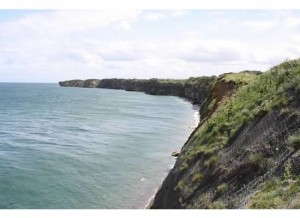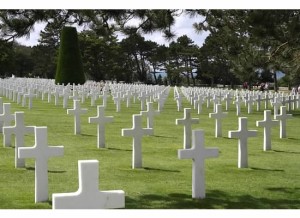June 6, 1944. The fate of Europe and the free world hung in the balance as more than 100,000 Allied troops stormed the beaches of Normandy. This day, which would go down in history as D-Day, was the beginning of the end for Adolph Hitler’s Nazi Germany. Today, the beaches of the Normandy region in France are relatively peaceful. However, they are still marked by permanent reminders of the crucial battle that was fought on this hallowed ground. I was privileged to visit Normandy last summer. During this day that I will never forget, we toured Gold Beach, where I enjoyed a crepe, Pointe du Hoc, and the American military cemetery at Omaha Beach.
Our first stop of the day was Gold Beach. Gold was one of the five code-named beaches that Allied forces landed at on the morning of June 6. Utah and Omaha were American beaches and Gold and Sword were British beaches, while Canadian troops landed at Juno Beach. Gold is situated in front of the town of Arromanches. Upon first arriving, we visited the museum, which explained not only what happened on June 6 but also focused on the Mulberry harbor that was built and extended out from the beach.
The British constructed large concrete blocks that were towed across the English Channel and then sunk into the water off of both Gold and Omaha Beaches. This created an artificial harbor that could be used for landing troops, equipment, and supplies until the Allies could capture a French port. The American Mulberry at Omaha was severely damaged in a storm in late June 1944 and was abandoned in favor of the port of Cherbourg, which was captured at the end of the month and made serviceable beginning in late July. For the British however, the Mulberry harbor at Gold would serve as the main port of supply until December when the Belgian port of Antwerp was liberated. Exiting the museum, we walked down to the beach. I was astounded by the sheer size of the mulberries, many of which still litter the beach. Walking up to one segment, I thought about the genius of the idea: being able to create this artificial harbor serviced the entire invasion force, which strengthened into the millions in the weeks and months after D-Day.
Prior to leaving for our next stop I was able to enjoy a delicious mid-morning snack—a crepe. I have had crepes in the U.S., but once again, nothing can compare to having the real thing. The crepe was steaming hot as I bit into it and the melted butter rushed into my mouth. And of course, what crepe would be complete without a rich French roasted coffee to wash it down?
Our next stop was Pointe du Hoc. Pointe du Hoc is a cliff right along the coastline, which the Germans fortified as a part of the Atlantic Wall. In order to eliminate the large gun emplacements atop the cliff, Army Rangers landed on the narrow beach below; they then used grappling hooks to scale the sides of the cliff and reach the German guns above, at great human cost. As I walked through the bunkers and looked over the edge of the cliff, I could not imagine what kind of heroism and extreme devotion to one’s country it would take to do what the Rangers did on D-Day. Pointe du Hoc is often overshadowed in the tale of the battle, but the sacrifice made here cannot be forgotten.
Our last stop of the day was Omaha Beach. After driving along the beach, the most famous of the landing sites in American lore, we headed to the American military cemetery. Walking the grounds of the cemetery brought back memories of the Punchbowl on Oahu and Arlington National Cemetery outside of Washington. However, the cemetery at Omaha had a greater impact on me than either of these. Perhaps this is only because I am older now, but the effect of seeing endless rows of crosses and stars of David stretching out in every direction made me very emotional and put me in a somber mood.
As I walked the rows, I thought of the ultimate sacrifice that these men gave for our freedom so that everyone at home might be spared the horrors wrought upon the European continent. I thought of my Grandpap, who fought in the Pacific during the Second World War. I thought of other family and friends who served in the war. As I thought, I realized that though this cemetery only held the remains of those killed in the early part of the invasion of France, their comrades in arms are slowly passing at home. The Greatest Generation gave so much for America’s freedom. They do not have long left, and they deserve our sincerest gratitude.
Next Week: The Amalfi Coast










I was not fortunate enough to visit Normandy while in France, and I can only imagine the impact it must have had to experience one of the most important pieces of American history. I appreciate the historical perspective you provide here (and in all of your posts). And might I say, I agree, crepes are quite delicious, and I didn’t begin to enjoy coffee until I visited France!
I had the opportunity to visit Normandy, France a few summers ago. Those images brought back great memories I had there. It was a really humbling experience to be able to visit the memorial there. I am sure you felt the same as well. Seeing all those crosses signifying a death of a single person experience really helps you put in perspective of the extend of war. I hope to go back one day in a few years and revisit Ohmaha beach and the memorial. It is certainly a place to see.
Normandy must be a very sobering place to visit as an American. So many allied soldiers died on the beaches. I really do want to visit someday and see the beachheads that France’s liberators landed on. Must have been an amazing experience.